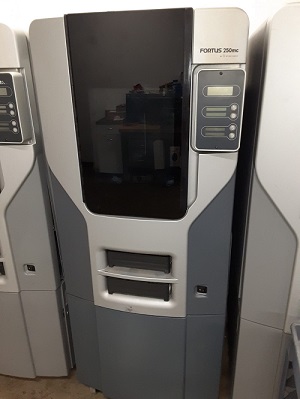Has your Stratasys Fortus 3D printer paused during a build?
Below, I have provided some of the most common causes and solutions to get your printer running again. This applies to all Fortus machines: 360mc, 400mc, 380mc, 450mc, 900mc, F900, and many other Stratasys FDM (fused deposition modeling) printers.
The most common error is a clogged tip or material blocked at the head. One common reason for this error is moisture in the filament. Due to the nature of FDM technology 3D printers melting and extruding polymers, moisture will turn to steam inside the liquefier blocks. The buildup of steam can push back on the filament as it tries to extrude. The Fortus Printer senses this backpressure; therefore, creating resistance and pausing the build. Signs of moisture-contaminated filament include: oozing from tips more than ¼” at building temps, bubbles present in extruded filament, the filament is brittle and breaking easily when bent, low part quality (stringing and/or pooling). Some materials are more sensitive to moisture than others. The higher the extrusion temperature, the more susceptible the material is to moisture and the issues it causes. Wet ABS might still print parts; although low quality, while not always causing the machine to throw an error for material blocked at the head or a clogged tip. This is all dependent on the amount of moisture present. Ultem 9085/1010 will produce low-quality parts and throw machine errors with only a small amount of moisture contamination. To rule out moisture, you should try using a new spool. If possible, it is suggested to use a new spool from a different lot #. The wet spool can be dried in the oven to be used again. A vacuum drying oven works best for this; you can even use the oven chamber on your printer if you have the time. The oven temperature will need to be 75°C for PC and Ultem materials and 65ᴼC for all other materials. Drying the spool can take anywhere from 12 to 60+ hours, depending on the amount of moisture.
Another factor that could be causing extrusion errors is a clogged tip or a tip nearing the end of life. The recommended extrusion life of a tip ranges anywhere from 600 to 1,000 cubic inches. A tip should only be used for the same material throughout its entire use. If you try to load another material, such as ASA or Nylon, with a tip that has extruded PC, then the tip will clog and/or give extrusion errors.
Debris in the filament pathway can lead to many issues for your Fortus 3d printer, which likely has four drive bays: two for model and two for support. Each of these two types of bays meets at what is called the Y-Block. After passing through the Y-Block, the filament enters a single tube that guides it to the print head. Debris and pieces of filament can build up or get stuck in the Y-Blocks. You can remove and inspect the Y-Blocks for clean throughput. The filament can also get stuck in the guide tubes. To check this, you can run a long piece of model filament through each guide tube and feel for excessive resistance. You might even be able to see where the filament is stuck. Running the separate piece of filament should help remove the jam. Two motors feed the filament from canister to tip: one at the drive block and one at the head. Extrusion issues will occur if one or both of these motors are failing, or near the end of their lives. If the printer continues to pause from blocked at the head or a tip clog, try switching material bays. Switching material bays can assist with determining if your drive block motor is operating properly.
In conclusion, there are several factors that could be causing your Fortus 3D printer to be giving extrusion errors. Verify there is no moisture in the filament, that you are using the tip for only one type of material throughout its lifespan, check that the tip is not clogged, and check if debris is present in the filament pathway.

